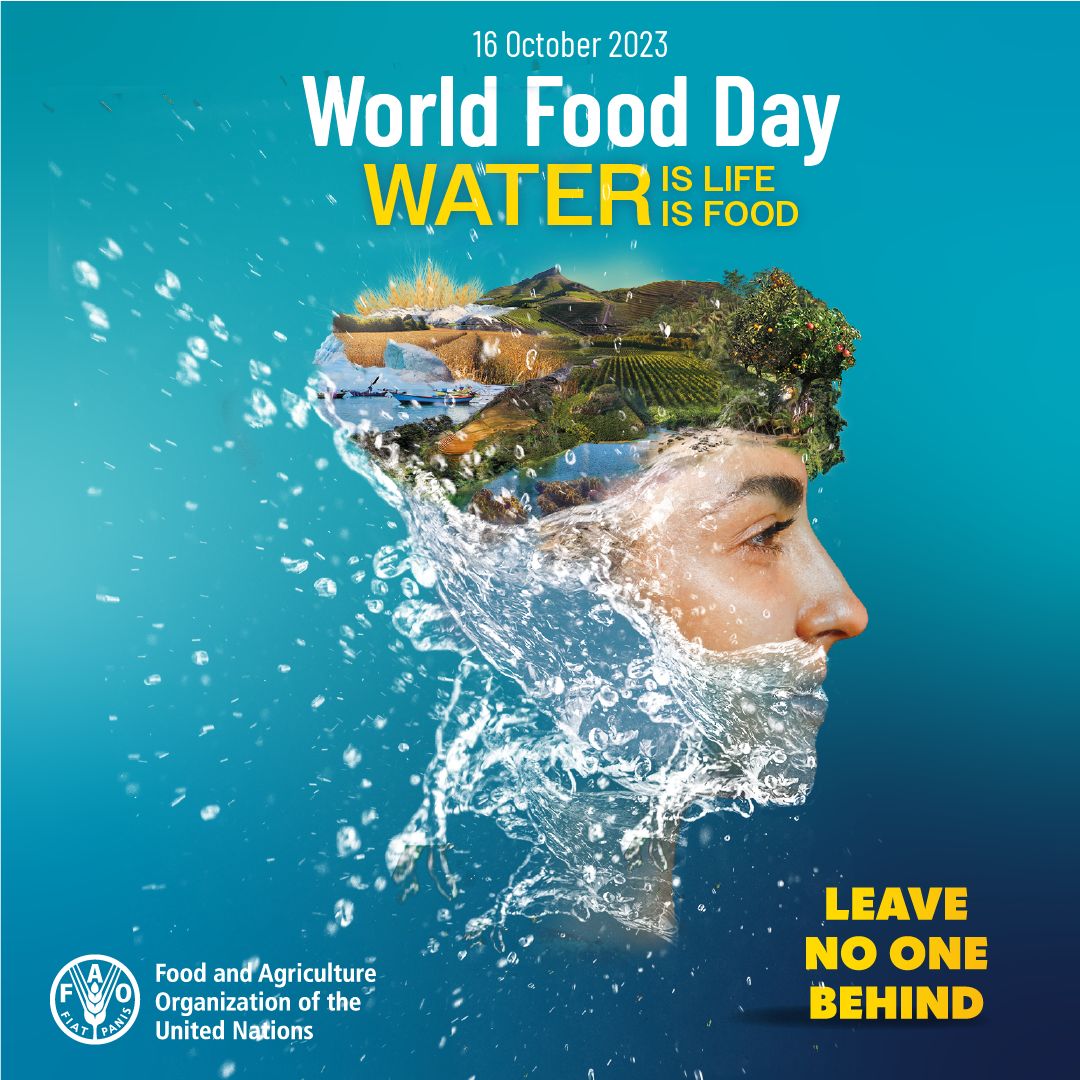Water: The Basis of Life and Food

Water, being the paramount resource for survival, has been a major concern on the global agenda for several decades. In today's changing world, it is of utmost importance to acknowledge the indispensable function that water performs in sustaining life and ensuring food security. Water is not merely a fundamental requirement for our existence, but also a pivotal element of our agricultural frameworks. Agriculture constitutes 72 percent of the total global freshwater withdrawals, but like all natural resources, fresh water is not infinite. In a contemporary world characterized by climate change, urbanization, and population growth, which collectively exert a mounting strain on water resources, it is imperative to judiciously manage and conserve water through innovative and sustainable solutions. This article aims to elucidate the crucial correlation between water, food production, and the holistic welfare of our planet. On the occasion of World Food Day 2023, the Food and Agriculture Organization of the United Nations (FAO) is raising awareness about the significance of water in ensuring food security. The theme chosen for this year of World Food Day is “Water is life, water is food. Leave no one behind.”
Water serves as a pivotal catalyst for people, economies, and nature, constituting the bedrock of our sustenance. Its indispensability to life on our planet cannot be overstated, as it comprises more than half of the physical composition of the human body and about 71 percent of the earth’s surface. Regrettably, a mere 2.5 percent of water is deemed fresh, rendering it suitable for drinking, agricultural practices, and most industrial uses. The global water demand is projected to persistently escalate at an annual rate of approximately 1 percent, leading to a surge ranging from 20 to 30 percent by 2050. Access to clean water and adequate food resources is considered a basic human right. However, millions of people across the globe continue to endure the absence of safe drinking water and face the challenges of food insecurity. Agriculture accounts for the largest share of global water usage, with irrigation being the primary consumer, however, changes in the global hydrological cycle and non-judicious use of fresh water have induced significant pressure on freshwater resources from the local to regional levels. Farmers rely on irrigation to cultivate crops and rear livestock, ensuring a steady supply of food. In the absence of adequate access to water resources, agricultural productivity declines, consequently resulting in scarcities of food and instances of malnutrition.
The global water crisis and its impacts
Despite the inevitable resource, millions of people around the world still lack access to clean and safe water sources. According to WHO and UNICEF, around 2 billion people do not have access to safely managed drinking water services and the global water crisis is alarming. Every day, a staggering number of over 700 children below the age of five succumb to diarrheal diseases linked to inadequate water and sanitation. Apart from many health-related issues, water scarcity poses a significant threat to achieving food security globally. As the global population continues to grow, the demand for food increases, putting pressure on water resources. The predicament is further aggravated by the effects of climate change, leading to unpredictable weather patterns, prolonged periods of drought, and water scarcity in many regions. Global warming which is considered as the primary adverse effect of climate change imposes various other abnormalities including the scarcity of water resources, disturbed hydrological cycle, reduced agriculture production, food insecurity, glaciers melting, rise in seawater level, and loss of biodiversity. The reduction of global water levels is considered a major threat to the decline of crop yield. As the water availability decreases, it triggers intra and inter-competition between and among different groups and may lead to conflict over the utilization of water resources. The consequences of water scarcity would be particularly severe in countries that rely on rice-based agricultural systems, where rice is considered a staple food crop like Nepal. In Asian nations such as China, India, and Pakistan, it is projected that 15-20 million hectares of rice cultivation areas will encounter a severe water shortage in the foreseeable future due to the high water requirements. For instance, in India, approximately 70 percent of irrigation water is used solely for rice cultivation. Studies have shown that approximately 600 million people, whose livelihoods rely, to some extent, on aquatic food systems, are currently experiencing the adverse consequences of pollution, ecosystem deterioration, unsustainable practices, and climate change.
Water scarcity and food production: future challenges
The availability and accessibility of water are the primary limiting factors for crop production, addressing this issue in areas affected by water scarcity is indispensable. The equilibrium between the demand for water and its availability has attained a critical juncture in many parts of the world. This increased demand for water and food production in the future calls for the adoption of sustainable approaches to water resource management in agriculture. Due to the escalating water scarcity and drought caused by climate change, significant water usage for irrigation is expected, leading to intense competition between agribusiness and other sectors of the economy. Furthermore, the projected increase in the global population growth rate indicates an inevitable rise in food demand, which will have an immediate impact on agricultural water usage. Nearly three-quarters of the freshwater is used in agriculture and globally water requirement for agriculture is expected to increase by 35 percent by 2050. There is a significant relationship between a country's water resources and its capacity for food production, it is crucial to assess irrigation requirements for effective water resource planning to meet food needs while avoiding excessive water consumption.
Global strategies to deal with water management
The implementation of efficient and sustainable water management practices, such as drip irrigation and precision farming, aids in the optimization of water usage by directly supplying water to the roots of plants, thereby substantially reducing wastage. Integrated water management strategies that combine water conservation, rainwater harvesting, and wastewater recycling can alleviate the stress on freshwater sources. Investing in sustainable agricultural practices, such as agroforestry and organic farming, can effectively reduce water consumption and safeguard soil quality, leading to long-term food security. In addition, it is crucial to enhance public awareness regarding the importance of water conservation and advocate for responsible water consumption. Educating communities about water-saving techniques, endorsement of water-efficient appliances, and implementing policies that incentivize sustainable practices are essential steps toward achieving a more water-secure future. Governments need to design and formulate science and evidence-based policies that capitalize on data, innovation, and cross-sectoral coordination to effectively plan and manage water resources. These policies need to be supported with increased investment, legislation, technologies, and capacity development while it is crucial to incentivize farmers and the private sector to engage in integrated solutions that promote the efficient utilization and conservation of water. Government and leaders should understand the water needs of local communities, address conflicts, improve water tenure governance, and ensure the equitable and peaceful distribution of water resources.
Sustainable management of water resources through climate-resilient strategies
Enhancing water storage capacity (rainwater storage), implementing equitable water supply and distribution policies, prioritizing river health, and watershed management are effective strategies for mitigating the adverse impacts of climate change on water resource availability. Similarly, the development of climate change-resistant crops, efficient water management in irrigation, adoption of climate-smart agricultural practices, and promotion of indigenous knowledge are crucial for ensuring food security by increasing agricultural yield. Technical interventions, such as the utilization of software, water management, nutrient management techniques, and instruments for measuring temperature and analyzing soil health, can equip farmers with the necessary scientific analyses for sustainable agricultural management. The collective efforts of various stakeholders, including farmers, local communities, academia, scientists, policymakers, and NGOs, are essential for achieving significant outcomes in reducing the vulnerabilities of agriculture and water resources to climate change.
Conventional and emerging agronomic practices for sustainable water management
To reduce water use and increase water use efficiency, several emerging irrigation systems have been reported, including alternate wetting and drying, saturated soil culture, and sprinkler and drip irrigation. These techniques have the potential to reduce water loss by impeding excessive evaporation, thereby promoting sustainability in cultivation and production. Additionally, various crop-specific agronomic practices, such as raised beds, aerobic rice, and the system of rice intensification, are employed to conserve water by manipulating tillage, crop establishment, irrigation volume, and the timing and frequency of water application. In Situ, crop residue management, cover cropping, crop rotation, mulching, green manuring, and contour farming are other approaches to sustainable water management. Interestingly, water use efficiency can be also increased by maintaining microbial diversity (for example mycorrhiza) in the soil. The development of drought-resistant varieties of crops by genetic interventions can help to reduce water requirements without compromising the yield, thus enhancing per-drop water productivity.
Sustainable water management in processing industries
At present, industrial usage accounts for less than 20 percent of global water consumption, but it is projected to increase fourfold by 2050. The food processing industry plays a crucial role in achieving sustainable development goals and is one of the largest consumers of water. Water consumption in food processing can be divided into two main categories: process functions, where water is used as a raw material, and non-process functions, where water is used for activities such as washing, cooling, and heating. The wastewater generated by food processing units, primarily from non-process functions, often contains high levels of organic and inorganic contaminants which can be separated and recovered through scientific procedures. Implementing novel approaches to water use management within the framework of a circular economy can promote resource recovery and enhance productivity and sustainability in food production. Circular economy strategies focus on reusing and recycling valuable resources, including water. Studies have demonstrated the positive impact of new process integration methods, such as water pinch and mathematical optimization, in maximizing water reuse and recycling. By applying these methods in the food processing industry, not only can water consumption be significantly reduced, but also wastewater generation can be minimized, thus contributing to environmental protection.
Efficient water use planning by modeling approach
Assessing future water availability is a challenging and crucial task in the face of changing climatic conditions and human interventions. The groundwater depletion can be tracked by using satellite-based technologies (like WaPOR) which help farmers and the government monitor the productivity of water in agriculture and aid in better planning for crop production. Optimization and simulation of computer-based approaches can contribute to a more equitable distribution of water resources for agricultural use. Thus, the estimation of future water availability through an integrated framework based on the Water Evaluation and Planning System (WEAP) has gained popularity in water use planning. Various simulation models, such as Soil and Water Assessment Tool (SWAT), Dynamic Conversion of Land-Use and its Effects (Dyna-CLUE), Modular Finite Difference Flow Model (MODFLOW), and AquaCrop Model, are employed in the water evaluation model to generate scenarios for future water resources.
Achieving universal access to clean water and ensuring food security for all is an essential component of the Sustainable Development Goals set by the United Nations. It is our collective responsibility to tackle inequalities and ensure that marginalized communities, including those residing in rural regions and developing nations, have equitable access to water and food resources. We need to increase the production of food with less water, simultaneously ensuring water is equally distributed, aquatic food systems are preserved, and nobody is left behind. This requires investment in technology, infrastructure, and education to improve water management, enhance agricultural productivity, and foster sustainable practices.










Leave Comment